the Creative Commons Attribution 4.0 License.
the Creative Commons Attribution 4.0 License.
Extreme wildfire events are linked to global-change-type droughts in the northern Mediterranean
Thomas Curt
Nicolas K. Martin-StPaul
Vincent Moron
Ricardo M. Trigo
Increasing drought conditions under global warming are expected to alter the frequency and distribution of large and high-intensity wildfires. However, our understanding of the impact of increasing drought on extreme wildfires events remains incomplete. Here, we analyzed the weather conditions associated with the extreme wildfires events that occurred in Mediterranean France during the exceptionally dry summers of 2003 and 2016. We identified that these fires were related to two distinct shifts in the fire weather space towards fire weather conditions that had not been explored before and resulting from specific interactions between different types of drought and different fire weather types. In 2016, a long-lasting “press drought” intensified wind-driven fires. In 2003, a “hot drought” combining a heat wave with a press drought intensified heat-induced fires. Our findings highlight that increasing drought conditions projected by climate change scenarios might affect the dryness of fuel compartments and lead to a higher frequency of extremes wildfires events.
- Article
(5490 KB) - Full-text XML
- BibTeX
- EndNote
There is increasing evidence that global changes are altering the distribution and frequency of the largest, most destructive extreme wildfires events (EWE) in different regions of the world (Trigo et al., 2006; Bowman et al., 2017) with ensuing economic, social and ecological impacts (Schoennagel et al., 2017). In a large number of ecosystems, anthropogenic ignitions are dominant and dead or live biomass is rarely limiting (Krawchuk et al., 2009; Pausas and Fernández-Muñoz, 2012). In these regions, fuel dryness therefore mainly regulates wildfires (Abatzoglou and Williams, 2016; Littell et al., 2016; Nolan et al., 2016; Fernandes et al., 2016; Turco et al., 2017). But while climate change is expected to increase the frequency and intensity of droughts in regions such as the Mediterranean (Hoerling et al., 2012), our understanding of the impact of increasing drought on EWE remains incomplete because of still-unresolved uncertainties.
First, meteorological drought is a complex phenomenon whose magnitude, length and timing depend on multiscale spatial and temporal interactions between evapotranspiration and precipitation (Ruffault et al., 2013). Several types of droughts can be defined depending on their characteristics (Hoover et al., 2015; Hoover and Rogers, 2016). “Press droughts” are subtle but chronic reductions in water availability, driven by long-term (month to seasons) reductions in precipitation and/or warmer temperatures, which increase potential evapotranspiration and reduce soil moisture (Hoover and Rogers, 2016). In contrast, “pulse droughts” (or “flash droughts”; Mo and Lettenmaier, 2016) are short in duration (days to weeks) but extreme in magnitude. When combined, press and pulse droughts may yield “hot droughts” (Overpeck, 2013).
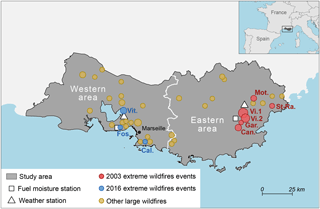
Figure 1Map of the study area in southern France showing (i) the location of summer large wildfires (> 250 ha) classified into three groups, (ii) the boundary of the areas delineating different climatic patterns and (iii) the location of weather and fuel moisture stations. The size of fire points is proportional to the size of the corresponding fire (min = 250 ha; max = 5646 ha). An individual description of the 2003 and 2016 extreme wildfires events can be found in Table 1.
Second, translating drought characteristics into fuel moisture content is not straightforward, because fire-prone ecosystems consist of several fuel compartments that respond to drought on different timescales (Pyne, 1996; Nolan et al., 2016). Fuel moisture of trees' and shrubs' living foliage responds to mid-term to long-term droughts because of the control of vegetation over water fluxes (Ruffault et al., 2013). In contrast, the fuel moisture of fine, dead fuels and surface litter responds to short-term (hours to days) dry atmospheric conditions (e.g., Resco de Dios et al., 2015).
Third, large fire climatology itself (i.e., typical local-scale weather conditions associated with fires) might not be unique within a homogeneous biogeographic area. Indeed, after observing that the weather conditions associated with large fire occurrence may be different in Mediterranean ecosystems, Ruffault et al. (2016) proposed a new hypothesis wherein large fire climatology was described as the coexistent combination of a limited number multi-scalar weather conditions called fire weather types (FWTs). The FWTs are the result of the linkage between instantaneous and antecedent regional weather patterns and theirs impacts on fire behavior. For instance, two main FWTs are generally observed in crown fires in forests and shrublands: wind-driven and heat-induced (Rothermel, 1991; Flannigan and Wotton, 2001; Jin et al., 2015; Duane et al., 2015; Ruffault et al., 2016, 2017; Cardil et al., 2017). Wind-driven fires are dominated by strong winds that accelerate the rate of spread. In contrast, heat-induced fires are linked to anomalously warm conditions that increase fuel dryness (Jin et al., 2015; Ruffault et al., 2016).
During the summers of 2003 and 2016, Mediterranean France (see Fig. 1) experienced several EWE that raised issues regarding how increasing drought conditions might affect fire activity. Indeed, despite growing efforts in fire management and suppression capacities implemented since the beginning of the 1990s (Fox et al., 2015; Ruffault and Mouillot, 2015; Curt and Frejaville, 2018), several fires became particularly large and devastating during these 2 years. Besides, the 2003 and 2016 summers are also known to be particularly dry in Mediterranean France, although they did not share similar climatic characteristics. Summer 2003 combined a long drought and a summer heat wave (Trigo et al., 2005), resulting in a “hot drought”. Summer 2016 was marked by a long-lasting “press drought” (French national meteorological institute; Météo-France, 2017; Fig. 2) while the anomalously warm temperatures were less extreme than in 2003. Interestingly, these two events closely reflect the expected impacts of climate change on drought that are projected in the Mediterranean (Sousa et al., 2011; Hoerling et al., 2012) and in other regions of the world (e.g., Mazdiyasni and Aghakouchak, 2015).
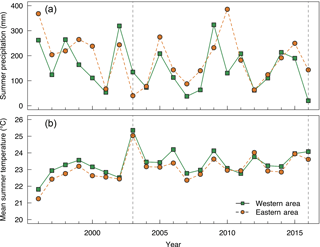
Figure 2Interannual variations in (a) precipitation and (b) mean daily temperature in the two studied areas. Dotted vertical lines indicate the 2003 and 2016 years.
Following these considerations, the overarching goal of this study is to determine whether the increasing drought conditions observed during the years 2003 and 2016 are responsible for extreme wildfires events in Mediterranean France. Specifically, we aimed to understand how the weather conditions observed during these summers, although different, led to extreme wildfire occurrence. Our hypothesis is that fire weather types have been affected by these two droughts. To answer these questions, we compared the weather and drought conditions associated with the 2003 and 2016 extreme wildfires with the historical climatology of large fires.
2.1 Study area
The study area includes two French administrative districts (Fig. 1, total area of 11 157 km2) recognized as two of the most fire-prone regions in France (Lahaye et al., 2014). The climate is Mediterranean with hot and dry summers, cool and wet winters and high interannual variability. Although these two districts share a large number of common climatic characteristics, interannual variations in the amount of precipitation can differ greatly between them because of the existence of a west–east gradient in precipitation variability over southeastern France (Fig. 2; see also Ruffault et al., 2017). Therefore, two distinct areas were considered in the following analyses (hereafter called the western and eastern areas; Fig. 1) based on the administrative borders of these districts. Fuels are similar in these two areas, consisting mostly of shrublands, pine forests, oak forests and mixed pine oak forests (Curt et al., 2013) but the western area, which includes the Aix–Marseille urban area, is more urbanized (average population density of 394 inhabitants km−2) than the eastern area (174 inhabitants km−2) (French National Institute of Geographic and Forest Information; IGN, 2016). The average yearly burnt area during the summer season (June to September) from 1996 to 2016 is 1393 and 1389 ha yr−1 in the western and the eastern area, respectively. Fire activity is highly variable from year to year and reached its highest level in 2003 (18 763 ha) and 2016 (4825 ha) in the eastern and western area, respectively (Fig. 3).
2.2 Fire data
Fire data for the summer season (June to September) were extracted from the PROMETHEE fire database (http://www.promethee.fr) for the period from 1996 to 2016. This database is managed by French forest services and provides reliable fire statistics with no major inconsistencies over the period examined (Ruffault and Mouillot, 2015, 2017). For each fire, PROMETHEE provides its ignition date, size and location of fires on a 2 km× 2 km grid. In this study, large fires were defined as fires greater than 250 ha in order to match the minimum size of EWE that occurred during the 2003 and 2016 fire seasons (see below). This size is rather small compared to other regions and ecosystems with relatively similar Mediterranean climate conditions, as seen in recent mega-fires in 2017 in Portugal or California. However, in Mediterranean France where landscapes are highly fragmented, only few fires reach extended surface and less than 0.4 % of fires exceed this 250 ha threshold for the period from 1996 to 2016 (http://www.promethee.fr).
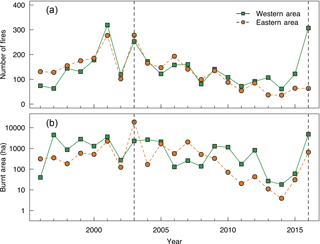
Figure 3Interannual variations in (a) number of fires and (b) burnt areas for the two studied areas. Dotted vertical lines indicate the 2003 and 2016 years.
Wildfires were then classified into three distinct groups: (i) EWE that occurred during the summer of 2003 in the eastern area (hereafter EWE_2003), (ii) EWE that occurred during the summer of 2016 in the western area (hereafter EWE_2016) and (iii) other large summer wildfires that occurred between 1996 and 2016 (hereafter OLW).
EWE were defined here as fires that caused or threatened to cause some economic, social or ecological damages. Because of the absence of a national, comprehensive and quantitative dataset on the vulnerability of landscapes to wildfires, EWE identification was based on a systematic literature review of scientific papers, governmental reports, newspaper articles or feedback from firefighters. We acknowledge that some subjectivity was unavoidable in this exercise, but as only few ignitions turn into large fires in Mediterranean France, large fires are systematically covered and well documented. In line with the detailed description of the 2003 summer fire season performed by Favre and Schaller (2004), six large wildfire events were particularly harmful and classified as EWE for the year 2003 (Table 1). For the year 2016, three wildfires were classified as EWE. These wildfires were extensively reported in the media and discussed by experts across the country, in part due to their large size but also because they threatened industrial, socioeconomical or ecological values (see Table 1). In fact, the occurrence of these three wildfires is one of the main reasons why we initiated our study. Finally, the OLW group consisted of all large wildfires that were not classified in either of the two previous groups (n = 29; median size = 520 ha).
2.3 Data analysis
The climatology of large fires was characterized by using the five following daily variables: temperature, wind speed, relative humidity and two proxies of fuel dryness on the medium (days to weeks) and long term (weeks to months). Only the weather and fuel conditions of the day of fire occurrence were analyzed because the main runs of large fires often occur on the first day in this part of the Mediterranean. The drought code (DC) and the duff moisture code (DMC) of the widespread Canadian Fire Weather Danger Rating System (CFFDRS; Van Wagner, 1987) were used as proxies of fuel dryness. The DMC is generally associated with the moisture content of slow drying surface fuels and is computed from daily rainfall, relative air humidity and air temperature during and prior to the fire day. The DC was initially developed to estimate the soil water content of relatively deep and compact duff and is generally associated with very slow drying fuels. It is calculated from daily rainfall and air temperature during and prior to the fire day. In the Mediterranean, DC has also been related with the moisture content of living shoots of plants, although the responsiveness of living fuel to weather can greatly vary among species according to their ability to dynamically adjust their water status (Viegas et al., 2001).
Daily climate records for precipitation, wind speed, temperature and relative humidity for the period 1996–2016 were obtained from climate stations. The two weather datasets were obtained from the Marignane (43.436∘ N, 5.215∘ E; altitude 5 m a.s.l.) and Le Luc (43.381∘ N, 6.385∘ E; altitude 80 m a.s.l.) meteorological stations for the western and eastern area, respectively (Fig. 1; Météo-France). Both stations are located close to the center of their respective area and 75 % of fires are within a 35 km perimeter of the station (Fig. 4).
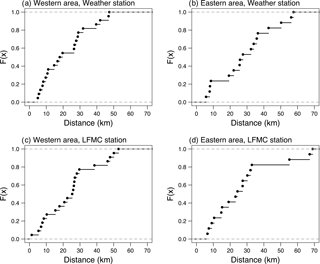
Figure 4Cumulative distribution function of the distance between large fires and the weather stations (a, c) and of the distance between large fires and the live fuel moisture content (LFMC) stations (b, d).
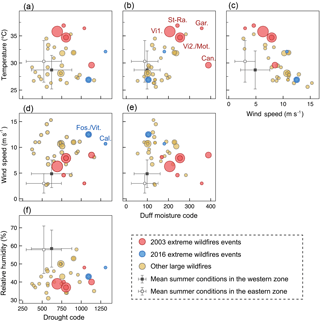
Figure 5Bivariate plots of the daily weather and drought conditions associated with summer large fires that were previously classified into three distinct groups. The size of fire points is proportional to the size of the corresponding fire (min = 250 ha; max = 5646 ha). The mean and standard deviations of summer weather conditions in each area are also shown. An individual description of the 2003 and 2016 extreme wildfires events can be found in Table 1.
In addition to the five above-mentioned drought proxies and weather variables, we also examined the seasonal and interannual variations in live fuel moisture content (LFMC) for distinct Mediterranean shrubs species sampled from nearby wildfire locations. Historical observations of LFMC for the 1996–2016 period were obtained from the Réseau Hydrique dataset, fully available in a Zenodo repository (Cabane et al., 2017). It provides weekly measurements of LFMC during the fire season (generally from May to September depending on the level of fire danger) for various species and sites of the French Mediterranean area. For each area, we extracted the closest site from the barycenter of the fires under study: Le Romaron (43.354∘ N, 5.166∘ E; altitude 152 m a.s.l.) and Le Haras du Rastéou (43.477∘ N, 6.483∘ E; altitude 147 m a.s.l.) for the western and eastern areas, respectively (Figs. 1 and 4). For each site, LFMC was examined for two species with distinct post-fire regeneration strategies (seeder and resprouter) as they generally display some distinct functional responses to drought (Vilagrosa et al., 2014).
2.4 Statistical analysis
Daily weather conditions were computed for each large wildfire and averaged for each fire group. Then, to assess whether and to what extent the climatology of the large wildfires of 2003 and 2016 differs from that of other large wildfires, fire climatologies were compared between them and with the mean summer daily conditions for the period from 1996 to 2016. For each weather variable, the significance of the difference between these groups was tested using the Welch modified t test, which is more reliable than the student t test when the two samples have unequal variances and unequal sample sizes (Welch, 1947). Besides, the daily and seasonal variations in weather conditions and fuel moisture content for the year 2003 and 2016 were also examined and compared to the mean climatic conditions.
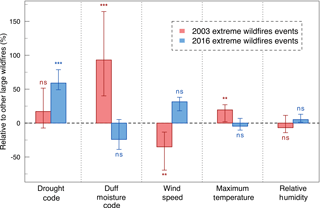
Figure 6Weather conditions associated with the 2003 and 2016 extreme wildfire groups. Values are shown relative to other large wildfires for the period from 1996 to 2016. Uncertainty bars represent the minimum and maximum values. For each weather variable, the significance of the difference in mean between the extreme wildfires groups and other large fires was computed with the Welch modified t test ( p < 0.001, * p < 0.01, ns: non-significant, p > 0.1).
The climatology of the three wildfire groups exhibited distinct patterns (Fig. 5). Wildfires belonging to OLW were associated with significantly higher daily wind speed (Welch's two sample t test, p < 0.001), lower relative humidity (p < 0.001) and both higher DC (p < 0.001) and DMC (p < 0.001) than the mean summer daily conditions for both areas (Fig. 5a, e and f). This is in accordance with the dominant wind-driven fire FWT observed in Mediterranean France (Ruffault et al., 2016, 2017). In contrast, we did not observe a significant difference between the temperatures associated with OLW and the mean summer daily conditions (p > 0.1; Fig. 5a).
The climatology of EWE_2003 considerably differed from that of OLW. On average, EWE_2003 was characterized by warmer (p < 0.001; Fig. 6) and drier (DC and DMC, p < 0.01; Fig. 6) conditions than those of OLW (Fig. 5a, e and f). Conversely, wind speeds associated with EWE_2003 were, on average, not different from the summer daily mean (p > 0.1) but significantly lower than that of OLW (Fig. 6).
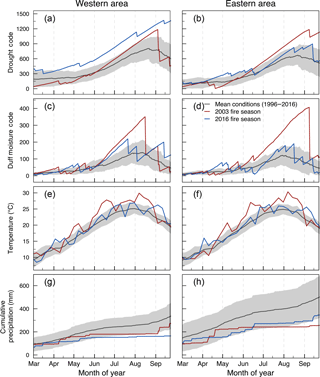
Figure 7Seasonal dynamics of weather conditions and drought indices during the 2003 and 2016 fire seasons in the western and eastern areas. Mean (black line) and standard deviation (shaded area) for the period from 1996 to 2016 are also indicated. All variables are shown at daily timescale expect temperatures that were averaged at weekly timescale for clarity.
The climatology of EWE_2016 was very similar to that of OLW. Indeed, as OLW, EWE_2016 climatology was also characterized by lower relative humidity (p < 0.001) and higher wind speed (p < 0.001), DMC (p < 0.001) and DC (p < 0.001) than the mean summer climatology (Figs. 5d–f and 6). However, EWE_2016 was associated with significantly higher values of DC than OLW and also than EWE_2003 (Figs. 5c and 6). Additionally, it is worth noting here that the “Calanque” fire (“Cal.” on Fig. 5d) exhibited both windy and quite hot conditions (Fig. 5c). This association is relatively unusual in Mediterranean France, where strong synoptic winds, usually blowing from the north, are generally associated with lower temperatures than usual (Fig. 5c; see also Ruffault et al., 2017).
Weather conditions and live fuel moisture content exhibited strong anomalies in the month before and during the summer of 2003 and 2016 (Fig. 7). These anomalies are in line with the exceptional weather conditions associated with EW2003 and EWE_2016 that were described above (see Fig. 5).
During the year 2016, DC was higher than usual in the western area (Fig. 7a) because drought onset conditions occurred earlier this year and precipitations during spring and winter were anomalously dry (Fig. 7g). The DC values observed during the summer 2016 were also the highest ever recorded over the period examined (not shown). Accordingly, the fuel moisture content of living vegetation was very low during that year, for both seeder and resprouter types of shrubs (Fig. 8a and c). In contrast, DMC and daily temperature were both close to the mean summer conditions (Fig. 7c and e). It is worth noting that these exceptional DC values were not observed in the eastern area (Fig. 7d), which indicates the local nature of this climatic event.
During the summer of the year 2003, temperatures were particularly warm from about 15 July to 15 August (Fig. 7e and f). Accordingly, DMC was also very high during this period and until the first half of September, especially in the eastern area (Fig. 7d). In addition, due to precipitation deficits during spring and summer (Fig. 7g and h), DC was also above the average conditions (Fig. 7c and d) but did not reach the levels observed in the western area during summer 2016. Interestingly, LFMC was generally lower than normal for both seeders and resprouters during the summer of 2003 (Fig. 8a–d) but also remained higher than the levels reached in 2016 over the western area.
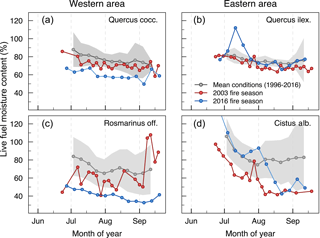
Figure 8Seasonal dynamics of live fuel moisture content during the 2003 and 2016 fire seasons in the western and eastern areas. Mean (points) and standard deviation (shaded area) for the period from 1996 to 2016 are indicated.
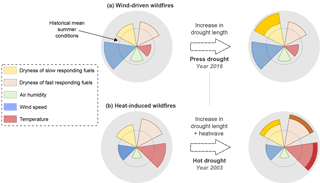
Figure 9Schematic representation of the changes on fire weather induced by global-change-type droughts and that are expected to increase the frequency of extreme wildfire events in the northern Mediterranean. Two distinct shifts in the meteorological fire niche resulted from specific combinations between the types of droughts and fire weather types (FWTs). Each grey circle represents the daily weather and drought conditions associated with fire occurrence. The inner circle represents the historical mean summer daily values. Each slice represents the anomaly of the corresponding variables compared to the mean daily summer values. Panel (a) shows the modification of the wind-driven FWTs with press droughts as illustrated by the 2016 fire season. Panel (b) shows the modification of the heat-induced FWTs with hot droughts as illustrated by the 2003 fire season.
Over the next century, climate projections for the Mediterranean basin converge towards an increased severity of droughts and heat waves, along with an elevated frequency of co-occurrence of these events (Sousa et al., 2011, 2015; Bador et al., 2017). While it is generally accepted that this warmer and drier climate will alter the frequency, intensity or severity of wildfires, major uncertainties remain about how it will translate into wildfire behavior and fire weather. In this paper, we analyzed the weather conditions associated with the EWE that occurred during the 2003 and 2016 exceptional summer droughts in the northern Mediterranean. On the basis of this analysis, we introduce a novel conceptual scheme summarizing the response of wildfire to climate change droughts, which combines the FWT framework adapted from Ruffault et al. (2016) and the drought classification from Hoover and Rogers (2016), which is depicted in Fig. 9. According to this framework, we propose that the exceptional drought of 2003 and 2016 induced two major shifts in the meteorological “fire niche”.
The first shift within the meteorological fire niche is expressed through the modification of the wind-driven FWTs by press droughts, as illustrated by the 2016 fire season (Fig. 9). Drought was longer and more intense than usual in 2016, due to an earlier accumulation of water deficits (since previous winter; Fig. 7a and g). Thus, although the 2016 EWE were clearly associated with the wind-driven FWTs (the dominant pattern in Mediterranean France; Ruffault et al., 2016, 2017), they were equally characterized by significantly drier-than-usual conditions. Taken together, the weather conditions associated with the 2016 EWE appear to represent a new configuration within the fire weather space (Fig. 5d), in which the probability of EWE occurrence might be increased. Indeed, such long and intense drought periods can lead to the substantial level of desiccation in the living vegetation compartments, as evidenced by the significantly lower LFMC during this year (Fig. 5a). This could lead to an increase in fire intensity and rate of spread and thereby reduce suppression opportunities.
The second shift within the meteorological fire niche is expressed through the modification of the heat-induced FWTs by hot droughts (Fig. 9), as illustrated by the 2003 fire season. Our results showed that a long-term water deficit (press drought; Fig. 7b) and a heat wave (pulse drought; Fig. 7f) occurred simultaneously during the summer of 2003. Several studies documented the exceptional nature of this climatic event that occurred over central and southern Europe (e.g., Trigo et al., 2005; Ciais et al., 2005). Consistent with these observations, the 2003 EWE in Mediterranean France were associated with very hot and dry conditions but low wind speeds, which are typical of heat-induced FWTs. However, the magnitude in temperature anomaly and short-term drought anomaly (illustrated here by DMC) observed in 2003 had never been observed before in the fire weather space (Fig. 5b). Mechanisms underlying this heat-induced FWT are still unclear but could be linked to the fast desiccation of plant during hot droughts (Williams et al., 2012; Allen et al., 2015), which can increase fire intensity and overwhelm fire suppression policies.
Alongside these shifts within the meteorological fire niche induced by increasing droughts, consideration should also be given to the possibility of climate change causing the emergence of new FWTs. In particular, some modifications in the interaction between large-scale atmospheric processes and regional-scale physiographic features can lead to the alteration of the relationships between the major instantaneous weather parameters for fire spread: temperature, humidity and wind. For instance, the association of hot, windy and dry conditions is relatively unusual in Mediterranean France because strong synoptic winds, blowing from the north, are generally associated with lower temperatures than usual (Ruffault et al., 2017) (see also Fig. 2c). So far, this constraint avoided the occurrence of “mixed FWT fires”, which combine strong winds and hot temperatures and are considered as one of the most critical FWTs in southern latitude countries (Pereira et al., 2005; Koutsias et al., 2012; Fernandes et al., 2016). But the weather conditions associated with the “Calanques” fire in the northern Mediterranean (Fig. 5c) suggest that this type of fire should be considered as an option in the near future. In this context, the large wildfires that occurred in 2017 in the eastern area should also be considered but additional analysis might help to provide further evidence for the emergence of new FWTs.
Our study suggests that “hot droughts” and “press droughts”, both anticipated to occur more frequently throughout the 21st century according to the vast majority of models, can lead to fire weather conditions that have not been explored before and to a subsequent increased frequency of EWE. Our results underline that the dryness of fuel is pivotal in the occurrence of EWE and therefore urges modelers to improve our estimations of fuel moisture dynamics (see for instance Nolan et al., 2016) and mortality events. Whether some possible changes in fire management could compensate for increasing droughts and its impact on wildfire behavior remains an open and important question.
Measurements of live fuel moisture content were provided by the Réseau Hydrique, France, and hosted in a Zenodo repository at http://doi.org/10.5281/zenodo.162978.
The authors declare that they have no conflict of interest.
This article is part of the special issue “Spatial and temporal patterns of wildfires: models, theory, and reality”. It is a result of the conference EGU 2017, Vienna, Austria, 23–28 April 2017.
This work is a contribution to the Labex OT-Med (ANR-11-LABEX-0061) funded
by the “Investissements d'Avenir”, a program of the French
National Research Agency (ANR) through the A*Midex project (ANR-11-IDEX-0001-02).
Ricardo Trigo was supported by FAPESP/FCT Project Brazilian Fire-Land-Atmosphere
System (BrFLAS) under grants FAPESP/1389/2014 and FCT 2015/01389-4.
Edited by: Marj Tonini
Reviewed by: two anonymous referees
Abatzoglou, J. T. and Williams, A. P.: Impact of anthropogenic climate change on wildfire across western US forests, P. Natl. Acad. Sci. USA, 113, 11770–11775, https://doi.org/10.1073/pnas.1607171113, 2016.
Allen, C. D., Breshears, D. D., and McDowell, N. G.: On underestimation of global vulnerability to tree mortality and forest die-off from hotter drought in the Anthropocene, Ecosphere, 6, 129, https://doi.org/10.1890/ES15-00203.1, 2015.
Bador, M., Terray, L., Boé, J., Somot, S., Alias, A., Gibelin, A.-L., and Dubuisson, B.: Future summer mega-heatwave and record-breaking temperatures in a warmer France climate, Environ. Res. Lett., 12, 74025, https://doi.org/10.1088/1748-9326/aa751c, 2017.
Bowman, D. M. J. S., Williamson, G. J., Abatzoglou, J. T., Kolden, C. A., Cochrane, M. A., and Smith, A. M. S.: Human exposure and sensitivity to globally extreme wildfire events, Nat. Ecol. Evol., 1, 58, https://doi.org/10.1038/s41559-016-0058, 2017.
Cabanne, E., Duché, Y., Savazzi, R., and Tchoukov, M.: Multisite and multispecies live fuel moisture content (LFMC) series in the French Mediterranean since 1996, ZENODO, https://doi.org/10.5281/zenodo.162978, 2017.
Cardil, A., Merenciano, D., and Molina-Terrén, D. M.: Wildland fire typologies and extreme temperatures in NE Spain, IForest, 10, 9–14, https://doi.org/10.3832/ifor1939-009, 2017.
Ciais, P., Reichstein, M., Viovy, N., Granier, A., Ogee, J., Allard, V., Aubinet, M., Buchmann, N., Bernhofer, C., Carrara, A., Chevallier, F., De Noblet, N., Friend, A. D., Friedlingstein, P., Grunwald, T., Heinesch, B., Keronen, P., Knohl, A., Krinner, G., Loustau, D., Manca, G., Matteucci, G., Miglietta, F., Ourcival, J. M., Papale, D., Pilegaard, K., Rambal, S., Seufert, G., Soussana, J. F., Sanz, M. J., Schulze, E. D., Vesala, T., and Valentini, R.: Europe-wide reduction in primary productivity caused by the heat and drought in 2003, Nature, 437, 529–533, https://doi.org/10.1038/nature03972, 2005.
Curt, T. and Frejaville, T.: Wildfire Policy in Mediterranean France: How Far is it Efficient and Sustainable?, Risk Anal., 38, 472–488, https://doi.org/10.1111/risa.12855, 2018.
Curt, T., Borgniet, L., and Bouillon, C.: Wildfire frequency varies with the size and shape of fuel types in southeastern France: Implications for environmental management, J. Environ. Manage., 117, 150–161, https://doi.org/10.1016/j.jenvman.2012.12.006, 2013.
De Angelis, A., Ricotta, C., Conedera, M., and Pezzatti, G. B.: Modelling the Meteorological Forest Fire Niche in Heterogeneous Pyrologic Conditions, PLoS One, 10, e0116875, https://doi.org/10.1371/journal.pone.0116875, 2015.
Duane, A., Piqué, M., Castellnou, M., and Brotons, L.: Predictive modelling of fire occurrences from different fire spread patterns in Mediterranean landscapes, Int. J. Wildl. Fire, 24, 407–418, https://doi.org/10.1071/WF14040, 2015.
Favre, C. and Schaller, P.: Les grands incendies de l'été 2003: bilan et analyse de la lutte, Forêt méditerranéenne, 25, 279–282, 2004.
Fernandes, P. M., Barros, A. M. G., Pinto, A., and Santos, J. A.: Characteristics and controls of extremely large wildfires in the western Mediterranean Basin, J. Geophys. Res.-Biogeo., 121, 2141–2157, https://doi.org/10.1002/2016JG003389, 2016.
Flannigan, M. D. and Wotton, B. M.: Climate, weather, and area burned, For. Fires Behav. Ecol. Eff., 351–373, https://doi.org/10.1016/B978-012386660-8/50012-X, 2001.
Fox, D. M., Martin, N., Carrega, P., Andrieu, J., Adnès, C., Emsellem, K., Ganga, O., Moebius, F., Tortorollo, N., and Fox, E. A: Increases in fire risk due to warmer summer temperatures and wildland urban interface changes do not necessarily lead to more fires, Appl. Geogr., 56, 1–12, https://doi.org/10.1016/j.apgeog.2014.10.001, 2015.
Hoerling, M., Eischeid, J., Perlwitz, J., Quan, X., Zhang, T., and Pegion, P.: On the increased frequency of mediterranean drought, J. Climate, 25, 2146–2161, https://doi.org/10.1175/JCLI-D-11-00296.1, 2012.
Hoover, D. L. and Rogers, B. M.: Not all droughts are created equal: The impacts of interannual drought pattern and magnitude on grassland carbon cycling, Global Change Biol., 22, 1809–1820, https://doi.org/10.1111/gcb.13161, 2016.
Hoover, D. L., Duniway, M. C., and Belnap, J.: Pulse-drought atop press-drought: unexpected plant responses and implications for dryland ecosystems, Oecologia, 179, 1211–1221, https://doi.org/10.1007/s00442-015-3414-3, 2015.
Jin, Y., Goulden, M. L., Faivre, N., Veraverbeke, S., Sun, F., Hall, A., Hand, M. S., Hook, S., and Randerson, J. T.: Identification of two distinct fire regimes in Southern California: implications for economic impact and future change, Environ. Res. Lett., 10, 94005, https://doi.org/10.1088/1748-9326/10/9/094005, 2015.
Koutsias, N., Arianoutsou, M., Kallimanis, A. S., Mallinis, G., Halley, J. M., and Dimopoulos, P.: Where did the fires burn in Peloponnisos, Greece the summer of 2007? Evidence for a synergy of fuel and weather, Agr. Forest Meteorol., 156, 41–53, https://doi.org/10.1016/j.agrformet.2011.12.006, 2012.
Krawchuk, M. A., Moritz, M. a, Parisien, M.-A. A., Van Dorn, J., and Hayhoe, K.: Global pyrogeography: The current and future distribution of wildfire, PLoS One, 4, e5102, https://doi.org/10.1371/journal.pone.0005102, 2009.
Lahaye, S., Curt, T., Paradis, L., and Hély, C.: Classification of large wildfires in South-Eastern France to adapt suppression strategies, in: Advances in Forest Fire Research, Ed. DX Viegas, Coimbra University Press, Coimbra, Portugal, 696–708, 2014.
Littell, J. S., Peterson, D. L., Riley, K. L., Liu, Y., and Luce, C. H.: A review of the relationships between drought and forest fire in the United States, Global Change Biol., 22, 2353–2369, https://doi.org/10.1111/gcb.13275, 2016.
Mazdiyasni, O. and AghaKouchak, A.: Substantial increase in concurrent droughts and heatwaves in the United States, P. Natl. Acad. Sci. USA, 112, 11484–11489, https://doi.org/10.1073/pnas.1422945112, 2015.
Mo, K. C. and Lettenmaier, D. P.: Precipitation Deficit Flash Droughts over the United States, J. Hydrometeorol., 17, 1169–1184, https://doi.org/10.1175/JHM-D-15-0158.1, 2016.
Nolan, R. H., Boer, M. M., Resco De Dios, V., Caccamo, G., and Bradstock, R. A.: Large-scale, dynamic transformations in fuel moisture drive wildfire activity across southeastern Australia, Geophys. Res. Lett., 43, 4229–4238, https://doi.org/10.1002/2016GL068614, 2016.
Overpeck, J. T.: Climate science: The challenge of hot drought, Nature, 503, 350–351, https://doi.org/10.1038/503350a, 2013.
Pausas, J. G. and Fernández-Muñoz, S.: Fire regime changes in the Western Mediterranean Basin: from fuel-limited to drought-driven fire regime, Climatic Change, 10, 215–226, https://doi.org/10.1007/s10584-011-0060-6, 2012.
Pereira, M. G., Trigo, R. M., Da Camara, C. C., Pereira, J. M. C., and Leite, S. M.: Synoptic patterns associated with large summer forest fires in Portugal, Agr. Forest Meteorol., 129, 11–25, https://doi.org/10.1016/j.agrformet.2004.12.007, 2005.
Pyne, S.: Introduction To Wildland Fire, John Wiley & Sons Inc., Hoboken, NJ, USA, 1996.
Resco de Dios, V., Fellows, A. W., Nolan, R. H., Boer, M. M., Bradstock, R. A., Domingo, F., and Goulden, M. L.: A semi-mechanistic model for predicting the moisture content of fine litter, Agr. Forest Meteorol., 203, 64–73, https://doi.org/10.1016/j.agrformet.2015.01.002, 2015.
Rothermel, R. C.: Predicting behavior and size of crown fires in the northern Rocky Mountains, USDA For. Serv. Intermt. Res. Station. Res. Pap. 46, USDA, Odgen, UT, 1991.
Ruffault, J. and Mouillot, F.: How a new fire-suppression policy can abruptly reshape the fire-weather relationship, Ecosphere, 6, 199, https://doi.org/10.1890/ES15-00182.1, 2015.
Ruffault, J. and Mouillot, F.: Contribution of human and biophysical factors to the spatial distribution of forest fire ignitions and large wildfires in a French Mediterranean region, Int. J. Wildl. Fire, 26, 498–508, https://doi.org/10.1071/WF16181, 2017.
Ruffault, J., Martin-StPaul, N. K., Rambal, S., and Mouillot, F.: Differential regional responses in drought length, intensity and timing to recent climate changes in a Mediterranean forested ecosystem, Climatic Change, 117, 103–117, https://doi.org/10.1007/s10584-012-0559-5, 2013.
Ruffault, J., Moron, V., Trigo, R. M., and Curt, T.: Objective identification of multiple large fire climatologies: an application to a Mediterranean ecosystem, Environ. Res. Lett., 11, 75006, https://doi.org/10.1088/1748-9326/11/7/075006, 2016.
Ruffault, J., Moron, V., Trigo, R. M., and Curt, T.: Daily synoptic conditions associated with large fire occurrence in Mediterranean France: evidence for a wind-driven fire regime, Int. J. Climatol., 37, 524–533, https://doi.org/10.1002/joc.4680, 2017.
Schoennagel, T., Balch, J. K., Brenkert-Smith, H., Dennison, P. E., Harvey, B. J., Krawchuk, M. A., Mietkiewicz, N., Morgan, P., Moritz, M. A., Rasker, R., Turner, M. G., and Whitlock, C.: Adapt to more wildfire in western North American forests as climate changes, P. Natl. Acad. Sci. USA, 114, 4582–4590, https://doi.org/10.1073/pnas.1617464114, 2017.
Sousa, P. M., Trigo, R. M., Aizpurua, P., Nieto, R., Gimeno, L., and Garcia-Herrera, R.: Trends and extremes of drought indices throughout the 20th century in the Mediterranean, Nat. Hazards Earth Syst. Sci., 11, 33–51, https://doi.org/10.5194/nhess-11-33-2011, 2011.
Sousa, P. M., Trigo, R. M., Pereira, M. G., Bedia, J., and Gutiérrez, J. M.: Different approaches to model future burnt area in the Iberian Peninsula, Agr. Forest Meteorol., 202, 11–25, https://doi.org/10.1016/j.agrformet.2014.11.018, 2015.
Trigo, R. M., García-Herrera, R., Díaz, J., Trigo, I. F., and Valente, M. A.: How exceptional was the early August 2003 heatwave in France?, Geophys. Res. Lett., 32, 1–4, https://doi.org/10.1029/2005GL022410, 2005.
Trigo, R. M., Pereira, J., Pereira, M. G., Mota, B., Calado, T. J., Dacamara, C. C., and Santo, F. E.: Atmospheric conditions associated with the exceptional fire season of 2003 in Portugal, Int. J. Climatol., 26, 1741–1757, 2006.
Turco, M., von Hardenberg, J., AghaKouchak, A., Llasat, M. C., Provenzale, A., and Trigo, R. M.: On the key role of droughts in the dynamics of summer fires in Mediterranean Europe, Sci. Rep., 7, 81, https://doi.org/10.1038/s41598-017-00116-9, 2017.
Van Wagner, C. E.: Development and structure of the Canadian forest fire weather index system, Canadian Forestry Service, Ottawa, ON, Canada, 1987.
Viegas, D. X., Piñol, J., Viegas, M. T., and Ogaya, R.: Estimating live fine fuels moisture content using meteorologically-based indices, Int. J. Wildl. Fire, 10, 223–240, https://doi.org/10.1071/WF01022, 2001.
Vilagrosa, A., Hernández, E. I., Luis, V. C., Cochard, H., and Pausas, J. G.: Physiological differences explain the co-existence of different regeneration strategies in Mediterranean ecosystems, New Phytol., 201, 1277–1288, https://doi.org/10.1111/nph.12584, 2014.
Welch, B. L.: The generalization ofstudent's' problem when several different population variances are involved, Biometrika, 34, 28–35, 1947.
Williams, P. A., Allen, C. D., Macalady, A. K., Griffin, D., Woodhouse, C. A., Meko, D. M., Swetnam, T. W., Rauscher, S. A., Seager, R., Grissino-Mayer, H. D., Dean, J. S., Cook, E. R., Gangodagamage, C., Cai, M., and McDowell, N. G.: Temperature as a potent driver of regional forest drought stress and tree mortality, Nat. Clim. Change, 3, 292–297, https://doi.org/10.1038/nclimate1693, 2012.






